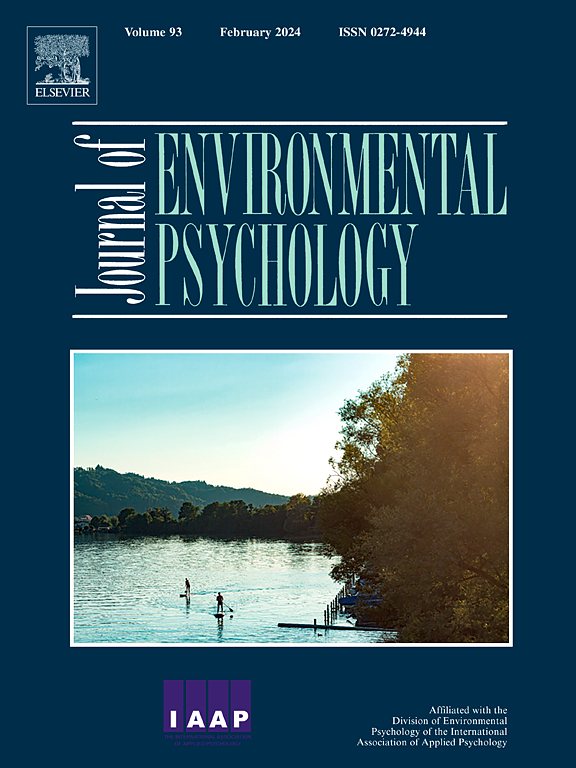Spatial density, basic psychological needs satisfaction and workplace attachment styles: a multigroup mediation model
IF 7
1区 心理学
Q1 ENVIRONMENTAL STUDIES
引用次数: 0
Abstract
Within the theoretical framework of Self-Determination Theory and Attachment theory, the aim of the present study is to understand whether the spatial density of offices, through the satisfaction of basic psychological needs, affects secure, avoidant, and preoccupied workplace attachment styles. The research was conducted with the voluntary participation of 190 office employees and employed a research design with three time points. At Time 0, information was collected regarding office size, the number of workers, and other sociodemographic variables. At Time 1 and Time 2, the satisfaction of basic psychological needs related to the office environment and the workplace attachment styles of employees were measured. The results show that spatial density impacts positively secure and negatively avoidant and preoccupied attachment styles, with the satisfaction of the basic psychological needs for competence and relatedness mediating this relationship. Practical implications are discussed.
空间密度、基本心理需求满足与职场依恋类型:一个多群体中介模型
在自我决定理论和依恋理论的理论框架内,本研究的目的是了解办公室的空间密度是否通过基本心理需求的满足,影响安全、回避和专注的工作依恋类型。本研究是在190名办公室员工自愿参与的情况下进行的,采用了三个时间点的研究设计。在时间0,收集有关办公室大小、员工数量和其他社会人口变量的信息。在时间1和时间2测量员工对办公环境相关的基本心理需求的满意度和工作场所依恋类型。结果表明,空间密度对安全型依恋和逃避型依恋有正向影响,对专注型依恋有负向影响,能力和关联的基本心理需求的满足在这一关系中起中介作用。讨论了实际意义。
本文章由计算机程序翻译,如有差异,请以英文原文为准。
求助全文
约1分钟内获得全文
求助全文
来源期刊

Journal of Environmental Psychology
Multiple-
CiteScore
10.60
自引率
8.70%
发文量
140
审稿时长
62 days
期刊介绍:
The Journal of Environmental Psychology is the premier journal in the field, serving individuals in a wide range of disciplines who have an interest in the scientific study of the transactions and interrelationships between people and their surroundings (including built, social, natural and virtual environments, the use and abuse of nature and natural resources, and sustainability-related behavior). The journal publishes internationally contributed empirical studies and reviews of research on these topics that advance new insights. As an important forum for the field, the journal publishes some of the most influential papers in the discipline that reflect the scientific development of environmental psychology. Contributions on theoretical, methodological, and practical aspects of all human-environment interactions are welcome, along with innovative or interdisciplinary approaches that have a psychological emphasis. Research areas include: •Psychological and behavioral aspects of people and nature •Cognitive mapping, spatial cognition and wayfinding •Ecological consequences of human actions •Theories of place, place attachment, and place identity •Environmental risks and hazards: perception, behavior, and management •Perception and evaluation of buildings and natural landscapes •Effects of physical and natural settings on human cognition and health •Theories of proenvironmental behavior, norms, attitudes, and personality •Psychology of sustainability and climate change •Psychological aspects of resource management and crises •Social use of space: crowding, privacy, territoriality, personal space •Design of, and experiences related to, the physical aspects of workplaces, schools, residences, public buildings and public space
 求助内容:
求助内容: 应助结果提醒方式:
应助结果提醒方式:


